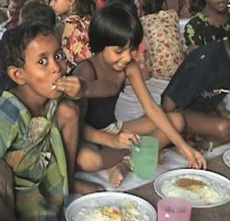India has 40% of the destitute in 49 countries: Oxford study
17 Jun 2014
India is home to 40 per cent of all poor people in 49 countries and is home to 343 million of the world's destitute, says an Oxford University study on poverty levels.
 With over 344 million destitute people, India is the second-poorest country in South Asia after strife-torn Afghanistan, according to the Multi-Dimensional Poverty Index (MPI) 2014, a tool used by Oxford researchers to measure poverty.
With over 344 million destitute people, India is the second-poorest country in South Asia after strife-torn Afghanistan, according to the Multi-Dimensional Poverty Index (MPI) 2014, a tool used by Oxford researchers to measure poverty.
While the overall the situation has improved for the world's poor due to poverty reduction programmes and economic growth, the study says, there is still a formidable core of extremely poor people.
The largest numbers of destitute people, 420 million, were found in South Asia. In India alone, drawing on the most recent official figures available, the Oxford researchers calculate around 343 million destitute people.
In sub-Saharan Africa, there are around 200 million destitute people, with the highest proportion found in Niger where over two-thirds (68.8 per cent) of the population were classed as destitute.
The 2014 study covered a total of 108 countries which are home to 78 per cent of the world's population. Some 30 per cent of them – 1.6 billion people – are identified as multidimensionally poor.
Of these 1.6 billion (85 per cent) live in rural areas, which is a markedly higher percentage than income poverty estimates of 70-75 per cent. Most of these poor live in South Asia (52 per cent), followed by Sub-Saharan Africa (29 per cent), and most – about 71 per cent - live in middle income countries.
The researchers classified one-half of all the poor in 49 countries as destitute by using MPI 2014, which identified a person as 'multi-dimensionally poor' if he or she is deprived in one-third or more of 10 indicators, such as severe malnutrition, losing two children, and defecating in open.
In South Asia, Afghanistan had the highest level of destitution at 38 per cent, followed by India at a 'troubling' 28.5 per cent. Interestingly, India's immediate neighbours Bangladesh and Pakistan had much lower levels of destitution at 17.2 per cent and 20.7 per cent, respectively.
The study placed Afghanistan as the poorest country in South Asia, with 66 per cent (based on 2010-11 data) of its people being MPI poor, followed by India with 54 per cent (2005-06), Bangladesh (2011) with 51 per cent, Pakistan (2012-13) and Nepal (2011) at 44 per cent, Bhutan at 27 per cent, and Sri Lanka and the Maldives at 5 per cent.
The researchers also named Bihar as the poorest region among 49 countries, followed by South Afghanistan. It said the poorest eight large Indian States were home to more MPI poor than the 28 poorest African countries, while admitting that India's data were from 2005-06 and needed an update, whereas those for the 25 African countries were more recent.
The study, however, noted that India reduced multi-dimensional poverty faster than income poverty.
The Oxford analysis of multi-dimensional poverty reduction in India was done using National Family Health Survey datasets from 2005. The MPI was created by Oxford Poverty and Human Development Initiative Director Sabina Alkire and Research Associate Maria Emma Santos, now at Universidad Nacional del Sur and CONICET, Argentina.
In 2014, the MPI has been widely updated and expanded, including substantial new analyses of rural-urban poverty, inequality among the poor, destitution and changes to poverty over time, an Oxford release said.